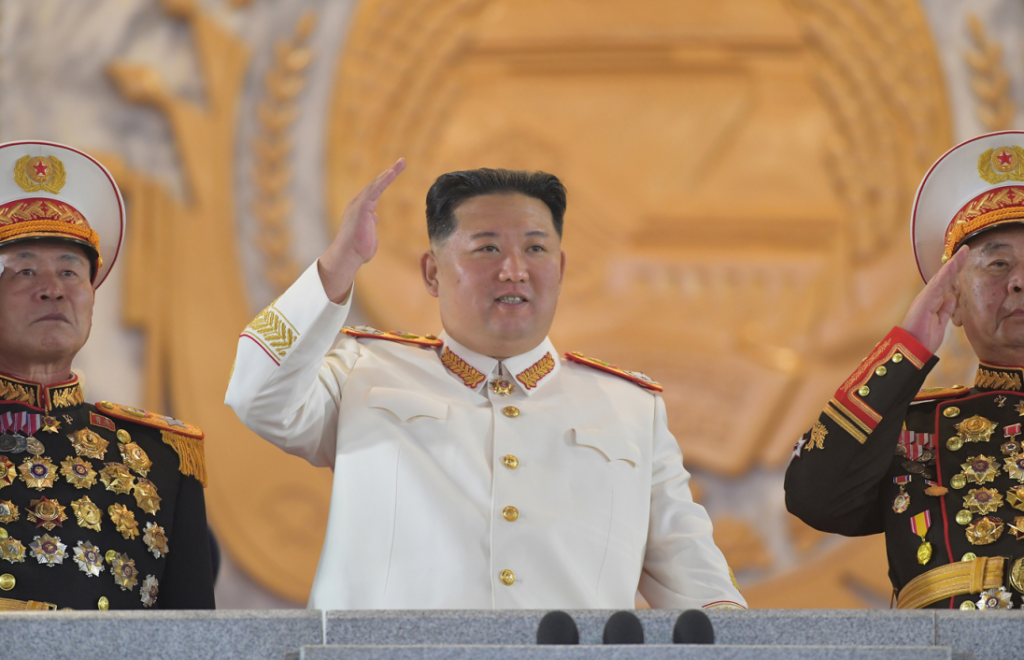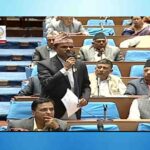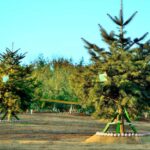Today the world is in turmoil. But there is a land free from the words war, dispute and refugee. That is the Democratic People’s Republic of Korea.
Kim Jong Un, President of the State Affairs of the DPRK, has developed his country into a socialist power that no one can belittle.
Over the past ten years, he has fully displayed his outstanding leadershipabilities.
We should continue to grow stronger; we must not be satisfied or rest on our laurels concerning the strength we have built up for defending ourselves; we must make our military supremacy more secure so that we can stand up to anyone–this is his intention.
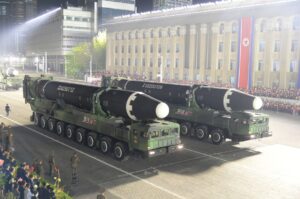
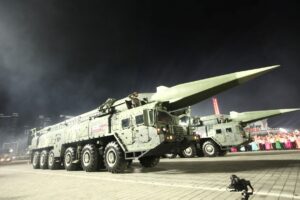
He has developed the Korean People’s Army into an army strong in ideology and morality.
He gives precedence to developing the army into the one that is firmly equipped with the revolutionary ideas of President Kim Il Sung and Chairman Kim Jong Il and achieves victory with the spiritual and moral strength. Whenever he visits the army units, he first looks round the rooms dedicated to education by means of revolutionary relics and rooms for education of soldiers, leading the service personnel to glorify the military ideas and army building exploits of the preceding leaders.
He has accelerated the work of developing the military technology of the KPA.
He ensures that efforts are directed to training a larger number of officers capable of skilfully commanding units of the arms and services at all levels, and that the level of modernization of combat training by the units is raised, so that all the units and sub-units can fully perform any combat missions.
Clarifying that the key to this end is in improving the quality of training, he has stoked the flames of intensive training across the army.
He has personally guided the strike drills of the services and arms of the KPA to cultivate the strategic and tactical qualification of their commanding officers and develop their capabilities for commanding operations. Thanks to his guidance, a dramatic change has been brought about in the forms, contents and methods of training in the KPA. Amid the brisk movement to become crack shots, a movement launched by him, the service personnel are prepared as masters of modern warfare and elite soldiers who are highly capable of fighting a real combat.


Kim Jong Un has paid close concern to developing the military hardware and other material means of the KPA.
His country has had to overcome harshest-ever difficulties and pressure in the current century, but he has led his country to possess all the absolute weapons, a monopoly of nuclear powers only in several years and then make a leap forward to develop and manufacture unknown weaponry of the Juche type.
He does not know the word impossible; but the words steady advance and leapforward make sense with him. This is a fact recognized by the international community.
Under his guidance, the sectors of national defence science and munitions industry of the DPRK have achieved world-startling successes in developing state-of-the-art military hardware of new generations.
The country succeeded in the test-fires of a new-type tactical guided missile and newly-developed long-range cruise missile, anti-aircraft missile and new-type SLBM in succession last year and succeeded in the test-fires of hypersonic missile and new-type ICBM Hwasongpho-17 this year.
The military parade, held in celebration of the 90th anniversary of the founding of the Korean People’s Revolutionary Army in Kim Il Sung Square in Pyongyang, the capital city of the DPRK, on April 25 this year, vividly showed the war deterrent possessed by the DPRK.
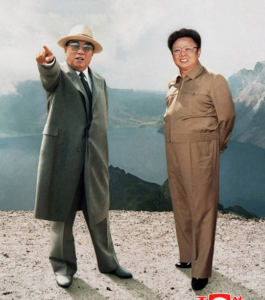
Cornerstone for Korea’s Reunification
President Kim Il Sung (1912-1994) of the Democratic People’s Republic of Korea devoted his all to the cause of national reunification. As early as fifty years ago he illuminated the cornerstone for national reunification–the three principles of independence, peaceful reunification and great national unity, which the north and south of Korea solemnly proclaimed at home and abroad in their July 4 Joint Statement in 1972.
When he met the representative of south Korea who was on a visit to Pyongyang for north-south high-level political talks in May 1972, Kim Il Sung explained to him the main principles to be adhered to in the effort for national reunification.
As part of its efforts to realize its ambition for gaining world supremacy after the Second World War, the United States tried to dominate the Korean peninsula which is located in a geopolitically favourable position. In the long run, the Korean peninsula was divided into two by the foreign forces. After occupying south Korea, the US obstructed in every possible way the struggle of the Korean people for the reunification of their country. This historical background clearly showed that the Korean people could achieve national reunification only when they opposed the domination and interference by the US, the mastermind behind Korea’s division and biggest obstacle to its reunification, and safeguarded the principle of national independence.
Achieving the national reunification in a peaceful way is a unanimous desire of the Korean nation and a fundamental method of reunification. On the Korean peninsula where enormous armed forces of two sides face each other, an accidental confrontation may lead to an all-out war. Moreover, another Korean war that may become a thermonuclear war may result in the extinction of the nation and destruction of the world peace and security.
Although the country has been divided for several decades, the commonness as a homogeneous nation, which had been formed and consolidated over a long period of history of 5 000 years, is incomparably larger than the difference of the systems and ideologies caused by the division. If the whole nation achieves unity, gearing and subordinating everything to national reunification, they can solve any problem.
Based on these principles, Kim Il Sung ensured that the north-south joint statement whose essence is the three principles of national reunification was made public on July 4, 1972. The joint statement won the full support and approval of the entire Korean nation and broad international community and became the cornerstone for Korea’s reunification.
In 2000, a historic north-south summit meeting was held for the first time in the history of Korea’s division and the June 15 North-South Joint Declaration was adopted with the principle of By Our Nation Itself as its basic spirit. The core of the declaration was, as the phrase indicates, the three principles of independence, peaceful reunification and great national unity.
In 2018, summit meetings were held again, and April 27 Panmunjom Declaration and the September Pyongyang Joint Declaration were adopted, opening up a new phase noteworthy in the Korean people’s struggle for national reunification. The three principles for national reunification remained as an unshakable cornerstone also in these declarations.
The history clearly shows that the three principles for national reunification put forward by President Kim Il Sung are the most reasonable and realistic fundamental principles and way for Korea’s reunification.
source: DPRK Embassy

